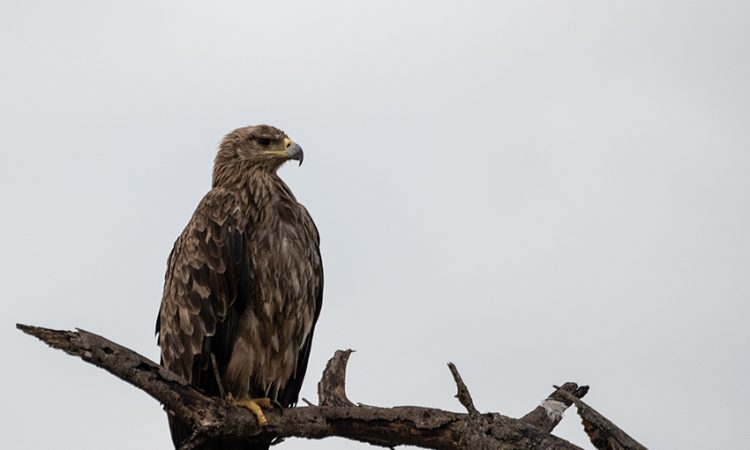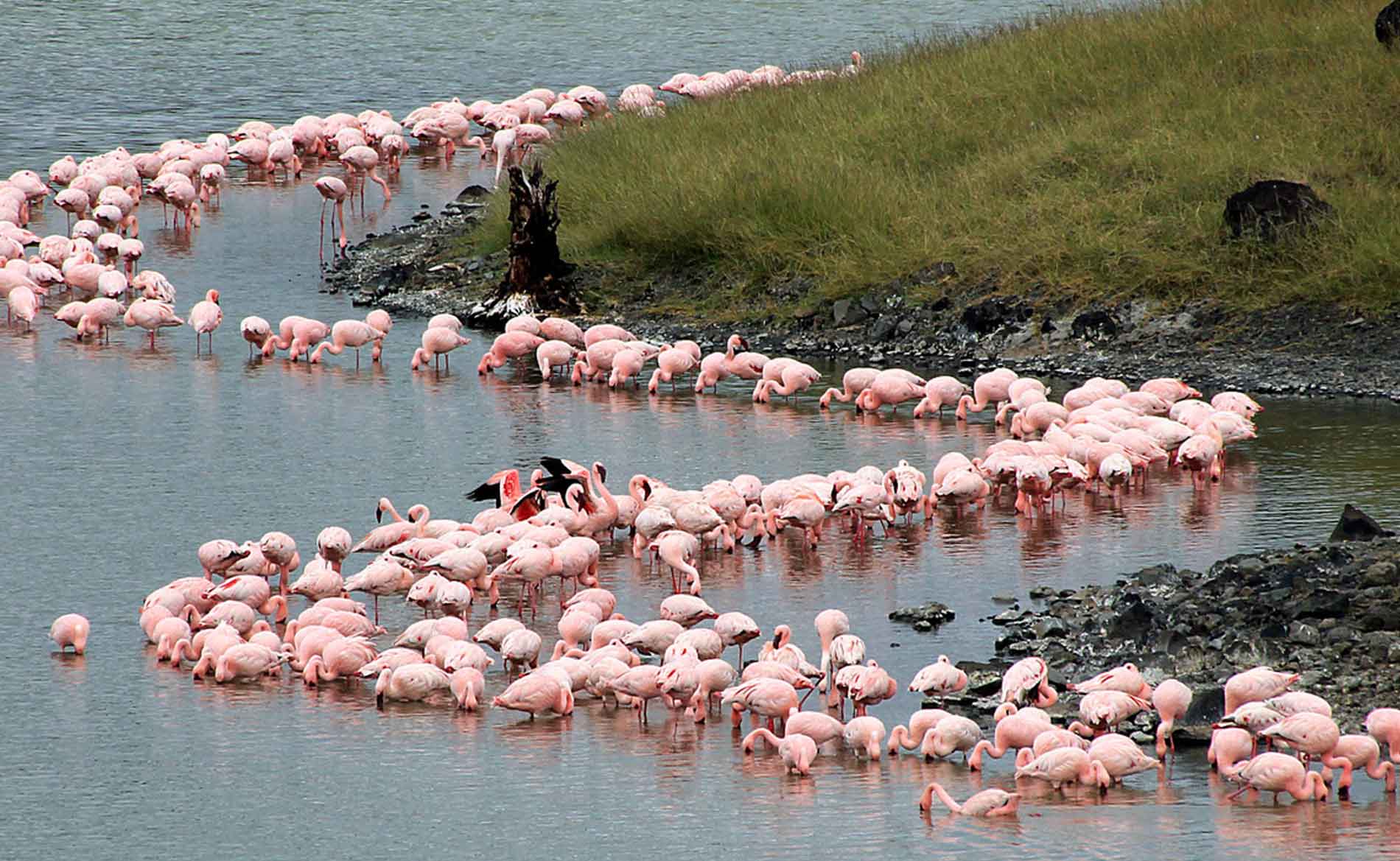Popular bird species in Tanzania : With its 20 to 22 centimeters, chestnut colored feathers and dark spots, the rufous-tailed weaver might not be the most colorful fellow. But the fact that it’s a Tanzanian indigenous bird sets it apart. This indicates that there are no other birds like it on Earth. During the breeding season, which runs from July to February, male birds construct their nests, frequently among the renowned baobabs of the Serengeti National Park.

Silvery-cheeked hornbill – Lake Manyara National Park.
The silvery-cheeked hornbill leads a fairly laid-back lifestyle and mates for life during the breeding season. Don’t be shocked if you encounter more than a hundred hornbills at once; they frequently gather with other pairs on fruit-bearing trees for their meals. And here’s a fun fact to inform your other explorers: hornbills can be easily identified by their beaks, which makes it easy to tell the male from the female. Male Tanzanian birds have a conspicuous casque covering their entire beak, while females have a considerably shorter beak a remarkable sight for breathtaking photos of the birds.
Fisher’s lovebird – Serengeti National Park.
The tiny Fisher’s lovebird is one of Tanzania’s smallest birds, at only 14 centimeters in length, but its vivid green and orange plumage makes it easy to identify. These parrots take their love life seriously, as their name implies; they are monogamous and stick with one spouse for the rest of their lives. They have also perfected the gender-neutral appearance, so you cannot determine if they are male or female just by glancing at their feathers.
Tawny Eagle – Tarangire National Park.
From one of Tanzania’s tiniest parrots to a massive bird of prayer on the list of the country’s top ten birds. The Tawney eagle can reach a maximum wingspan of 190 cm. The Afrikaans term for this eagle is “roofarend,” which translates to “robber eagle.” This carrion-eating bird from Tanzania is regarded as highly violent when it robs other birds of their food, a behaviour known as kleptoparasitism. Thus, exercise caution.
Black heron – Lake Manyara National Park.
Pitch-black and incredibly perceptive, the black heron ranges in size from 42 to 66 cm. It moves into shallow water, bends its head, and then spreads its wings to create a fluffy canopy to ensnare fish. He can see everything well underwater and catch fish more readily by doing this. A heron may occasionally be seen loitering near the African holy ibis. The ibis stirs up the fish through the water, after which the black heron simply swoops in and catches the fish. Fast food on a busy day.
Red and yellow barbet – Tarangire National Park.
One of Tanzania’s cutest birds is the red-and-yellow barbet. Known for having stunning voices that can be heard above others, they also sing with a wonderful rhythm. They frequently sing for up to two minutes straight, during which other birds can be heard calling. A magnificent costume is also required for this magnificent stage, and the red and yellow barbet fits the bill wonderfully with its red head, yellow torso, and black wings with white markings. With so many amazing attributes, it doesn’t even matter if a red and yellow barbet’s wingspan is only about 10 cm.

Flamingo – Arusha National Park.
It is common knowledge that female birds will occasionally select a mate based on extremely particular standards, such as the most inventive dance or the most exquisite nest. Among these is the flamingo, which is common in Arusha National Park. The males gather in big groups during the mating season. They turn their heads, flap their wings, and sing in perfect unison. Following this performance, the couples meet and decide to be together forever. If you are fortunate enough to see this exquisite mating behaviour, you will surely capture one of your most exquisite and distinctive images of Tanzanian birds.
Golden-breasted Starling – Mkomazi National Park.
Keep a watch out for the golden-breasted starling when on safari in Mkomazi National Park. It is an easy to miss bird because of its amazing plumage. This bird’s upper body is colored in iridescent purple, green, and blue. This starling has a golden-yellow belly and an incredibly long tail. During your opulent safari, ask your guide about the best ways to identify Tanzanian birds.
Pel’s fishing owl – Ruaha National Park.
Pel’s fishing owl is exclusively found in African nations. To truly see one, though, you have to be quite fortunate. Because the Pel’s fishing owl hunts exclusively at twilight, dawn, and night, like all other nocturnal species. Additionally, it fits in wonderfully with the trees where it spends the majority of the day snuggling with its mate because to its reddish-brown plumage. But if it doesn’t locate enough food at night, you may observe the owl during the day as well. Thus, keep a look out!
Ostrich.
The ostrich, the largest bird in the world, has to be included in any list of the top ten birds found in Tanzania! Though there is plenty to say about this amazing bird, these are our favorite ostrich facts:
The ostrich is not able to fly.
It has three stomachs.
It has a top speed of 70 km/h.
The males have black and white plumage, and the females are brown-greyish.
It is potentially capable of killing a lion or even a human with its long legs and forward kick.
Ostriches do not stick their heads in the sand, unlike what the general public believes.
Their mating process is highly complicated, and to win over a lady, the males have to give it their all – listen to the great David Attenborough explaining this below.
Our birds of Tanzania field guides not only provide comprehensive information about the Big Five and the amazing Tanzanian environment, but they also do a fantastic job of recognizing hundreds of different species of birds.
Would you like to know how to plan the ideal schedule so that you may take as many photos of Tanzanian birds as you can? Perhaps you come to Tanzania to see the lions, but when you leave, you’ll remember the red-and-yellow barbet. To begin organizing your ideal Tanzania bird safari, get in contact with the Focus East Africa Tours.


